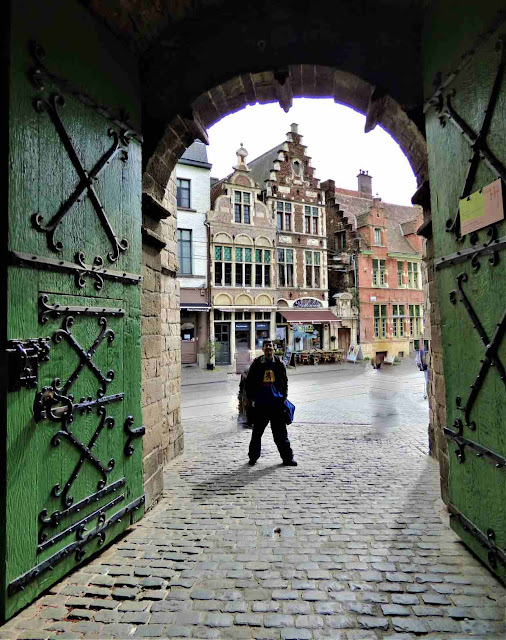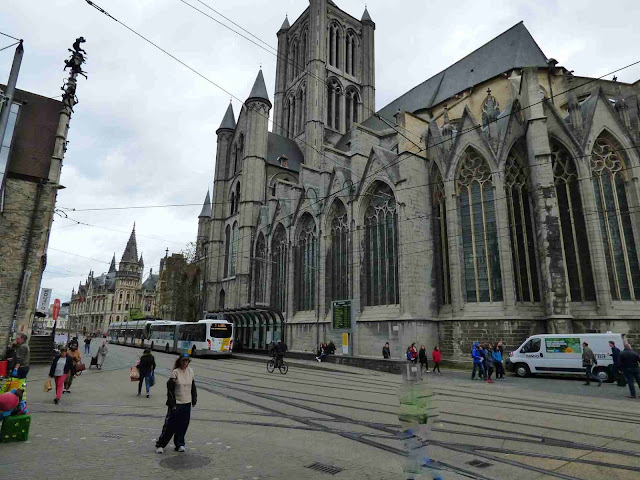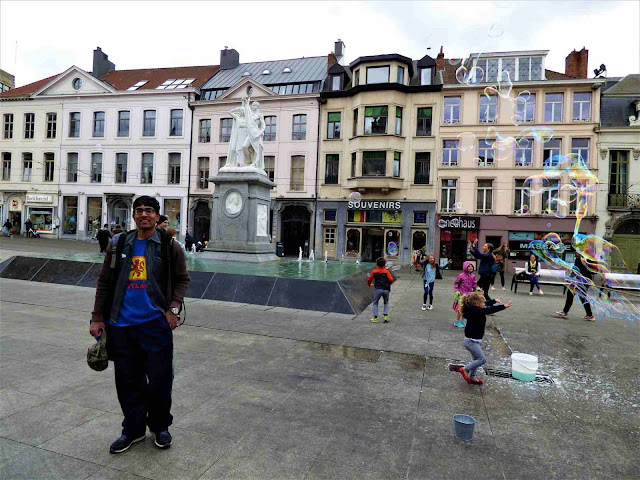The old city of Ghent (in Flemish Gent;
in French Gand) is a picturesque muddle of alleyways rimmed by quaint
steeple-roofed buildings running along pretty canals. Along
with Bruges, Ghent is Belgium's star architectural attraction.


City of Ghent was born near the
confluence of the rivers Scheldt and Leie. And its name actually
derives from Ganda, the Celtic word for confluence.
https://visit.gent.be/en
is the official site with plenty of info
We made our google map walking plan as follows:
We made our google map walking plan as follows:
GHENT walking map part 1 upto Nikolas
church
GHENT walking map part 2 upto
Vrijdagmarkt
GHENT walking map part 3
Day 14: 27 April 2019, Thursday:
We checked out of our hotel at 7 am.
Took our bags to the Centraal station and put them in a locker for
€4,50. We already had bought tickets to Leiden Centraal which was
valid for the whole day.
We planned to take the train at 4.50 pm headed to Schipol; we would get down at Rotterdam and take a connection to Leiden Centraal; total trip in 2 ½ hours
We planned to take the train at 4.50 pm headed to Schipol; we would get down at Rotterdam and take a connection to Leiden Centraal; total trip in 2 ½ hours
Now in the morning we were headed to Ghent for a day trip. The electronic board near the lockers
was showing only immediate trains. We did know our options and should
have taken the fast train like the previous day to Bruges. 7AM IC
428 TO OOSTENDE...midi, gent and reaches bruges
7,20 am bruges
7,28 Courtrai / Kortrijk one change at
Ghent
7,49 Blankenberge/knokke
Made a mistake and got on a slow train
with destination Ghent which stopped at umpteen stations and took an
hour to reach Ghent. Rain had been predicted for the day and we were
wearing our rain pants. We filled our passes with the info on our
trip and got down at Ghent station Gent Sint-Pieters after a
unnecessarily LOONG trip.
We need to catch tram 1 from in front of the station as it is a 25 - 30 minute walk with not much to see along the way. We went out the wrong exit and the tram stops did not have tram 1 sign. We asked around, went into the station and got out the correct exit.
We need to catch tram 1 from in front of the station as it is a 25 - 30 minute walk with not much to see along the way. We went out the wrong exit and the tram stops did not have tram 1 sign. We asked around, went into the station and got out the correct exit.
We can either buy 2 single tickets for
€3 each - in this case, the same whether on board the tram or from
the ticket machine; or a 1-day card from the ticket machine for €6
- would be €8 if bought from the tram
driver : https://www.delijn.be/en/vervoerbewijzen/ritkaarten-
dagpassen/dagpas.html
-
We had to take tram #1, direction Wondelgem/Evergem, the stop we need for Graslei is either Korenmarkt or - walking back a bit - the next stop, Gravensteen which is the stop for the castle and tourist office.
We had to take tram #1, direction Wondelgem/Evergem, the stop we need for Graslei is either Korenmarkt or - walking back a bit - the next stop, Gravensteen which is the stop for the castle and tourist office.
We got 4 tickets from the Info center at the station
and took the tram. Validated the tickets by inserting in the machine on the tram and got it time stamped. Huge fines otherwise. Got down at Gravensteen stop
In front of the castle extends the ancient Sint-Veerleplein, the oldest square in Ghent, although the neighboring facades are of 17th-century origin. This square was a marketplace but also the site of executions and burnings of the victims of the Inquisition
The Baroque building at
Sint-Veerleplein No. 5 is the old fish market, built in 1689
according to plans by Artus Quellin. The gateway depicts Neptune and
allegorical representations of the Scheldt (male) and Leie (female).

To the northeast, the Kraanlei Canal adjoins Sint-Veerleplein, all lined with elegant houses. Immediately on the left is No. 1, the Craenenburgh, then the row of houses De Lelye(No. 3-11), built around 1500 in Brabant Gothic style. No. 13, In den Bliekenmarkt is a former fish shop. Further along the Kraanlei is house No. 75, De Klok, dating from the 17th century, with a spiral staircase and decorated with numerous allegorical reliefs. No 77., De Zeven Werken van Barmhartigheid, and No. 79, Het Vliegend Hert, are Baroque 17th-century town houses, decorated with exquisite reliefs

To the northeast, the Kraanlei Canal adjoins Sint-Veerleplein, all lined with elegant houses. Immediately on the left is No. 1, the Craenenburgh, then the row of houses De Lelye(No. 3-11), built around 1500 in Brabant Gothic style. No. 13, In den Bliekenmarkt is a former fish shop. Further along the Kraanlei is house No. 75, De Klok, dating from the 17th century, with a spiral staircase and decorated with numerous allegorical reliefs. No 77., De Zeven Werken van Barmhartigheid, and No. 79, Het Vliegend Hert, are Baroque 17th-century town houses, decorated with exquisite reliefs
GRAVENSTEEN (CASTLE OF THE COUNTS):
After this armor paraphernalia, we went up the steps, the door was jammed shut. People on the terrace had to push from their side to get the door to open. [Some people even missed going up thinking the door can't be opened! Even we had gone up earlier and had got stumped]
Great views from the tower.
The door left bottom of picture below is the entrance/exit
It was fun roaming around the ramparts
After the castle visit we had a scenic walk following this excellent guide.
https://visit.gent.be/sites/default/files/content/brochure/files/NOTENDOP-UK_2018.pdf
GRASLEI:
Some of Belgium's finest guild houses
are along the Graslei Canal.
Checked out the adjoining Gildehuis der Vrije Schippers (House of
the Free Boatmen), built in 1531 in the Brabant Gothic style,
and Gildehuis der Graanmeters (House of the Grain
Weighers), with its stepped gable that dates from 1698.
Further
along, is Tolhuisje (Customs House), a Flemish
Renaissance building of 1682.
It stands next to Romanesque Spijker or Koornstapelhuis (around 1200).
It stands next to Romanesque Spijker or Koornstapelhuis (around 1200).
The Gildehuis der Metselaars (House of the Masons)
from 1527 in Brabant Gothic style completes this unique row of guild
houses.
This is the famous Grasburg...Ghent's picturesque bridge
KORENLEI:
Korenlei is the Left bank of the river Leie... Graslei is the opposite bank

We see St Nicholas church in the middle of the next few pics
Painting on building facade
The splendid Cloth Hall directly adjoins the belfry. This building (1426-1441) by Simon van Assche was the meeting place of the wool and cloth traders and was converted into a prison in the 18th century. Today, it has a café-restaurant, which is popular with tourists


ST NICHOLAS CHURCH:
This is St Nicholas Church. We went in and enjoyed the lovely sculptures, stained glass and paintings.
Said hi to St Peter with his Golden key to the Heavens
How many pigs can you spot in this pic??
St Nicholas Church... another facade

On the west side of Sint-Baafsplein stands the 91-meter-high belfry, symbol of the city's independence, where the charters of the privileges of Ghent were kept. [ It is one of the 3 medieval towers of old Ghent, the other 2 belonging to St Bavo cathedral and St Nicholas church]. Through the centuries, the belfry served not only as a bell tower to announce the time and various warnings, but also as a fortified watchtower and the place where the documents evidencing the municipal privileges were kept
In the basement of the Belfry are the stone sculptures representing the watchmen... only one is original.
Lovely views .
This is the Original gilded copper dragon (1377)
On the eastern side of Sint-Baafsplein stands the Cathedral of St.Bavo, a majestic building of brick and granite with a Romanesque crypt of its predecessor,
The High Gothic cathedral choir dates from the 13th century, while the late Gothic tower and the main nave were built during the 15th and 16th centuries.
Belfry in the background...

ST BAVO CATHEDRAL:
We went into the Bavo Cathedral. The light interior of the cathedral is richly decorated with some unique paintings. These include The Conversion of St. Baaf by Peter Paul Rubens (1624) and Christ among the Doctors by Frans Pourbus (1571).The most famous artwork here is The Altar of Ghent, also known as The Adoration of the Mystic Lamb, renowned as by far the greatest masterpiece of old Flemish painting. We bought the ticket and enjoyed that too. No pics allowed.
The whole church is stunningly beautiful!
Below the main church, the extensive crypt contains numerous tombs of bishops and a rich treasury. The outstanding Calvary triptych of 1464 by Joos van Wassenhove (Justus van Gent) is also shown in one of the chapels.
It started drizzling. We walked on.
Built over a long period of time, Ghent's magnificent town hall combines a variety of architectural styles. the oldest parts of the building on the Hoogpoort, completed in the style of Bruges City Hall in 1482 contain the council chambers,
the architects built a new wing in the finest late Gothic form, richly decorated with statues. However, building work on this part, which is best seen from the corner of Hoogpoort and Belfortstraat, was suspended because of religious disputes in 1539.
Only a quarter of the original plan was realized and only the Peace Hall (Pacificatiezaal; actually the courtroom for the Keure, the protectors of the town constitution) and the Marriage Chapel, both 1535, were built.
Work only resumed at the end of the 16th century, so that the wing facing the Botermarkt is in Renaissance style as is the Throne Room on the upper floor.



Nice church... it was closed though...
Lovely totem pole
AWESOME architecture everywhere...
This is the Old Market (Groentenmarkt) began life as a fish market and then in the 18th-century began functioning mainly as a vegetable market.
In the medieval era, Ghent's pillory stood here. On the west side of the market area is the long Groot Vleeshuis, a medieval covered meat market with a guild house, chapel, and numerous gables in the roof. The building originated in 1406-1410 and was restored in 1912.
At the south end of the Vleeshuis is the Penshuizeken (entrails cottage) where the poor were given the entrails of slaughtered animals. Today, the Vleeshuis building is a rather fine restaurant,
We got into a tram, validated our tickets and made our way to the station. Boarded a train to Brussels. Filled up our pass using up the last lines. We had got into the 1st class by mistake along with quite a few others, the ticket controller told us to shift, no fine thankfully.
TRAIN TO LEIDEN, NETHERLANDS:
We reached the Brussels station, collected our bags from the locker. We had just missed the 4. 50 train going to Schipol. We waited for the train at 5.50 and got in.
We had to transfer at Rotterdam. We had reached the penultimte station Breda. The train started to slow down. We were surprised as Rotterdam is not that close to Breda. The train stopped and an announcement came that there is some problem with the software..
We sat on for an hour or so, a relief train was supposed to come. then they decided to take the train back to Breda. Told us which platform we had to go for catching our relief rain. We boarded that train and got down at Rotterdam. Looked at the electronic board and a connection to Leiden Centraal was available within a minute. We sprinted to that platform and got into that train.
We reached Leiden Centraal well past 10 pm. We had booked Ibis Leiden Centraal for that one night... we had prior booking at Tulip Inn Leiden Centraal for the next 2 nights.
Ibis Leiden Centraal was fine.
It had been such a day of unnecessary DELAYS.
Anyway, Ghent had been GREAT ... such a lovely medieval city...
The next day, we wanted to catch the 8 am bus to Keukenhof... we had our tickets already bought online. We slept off dreaming of castles and medieval magic.
Belgium is a beautiful country. We would definitely be back to spend more time
Report on our terrific three days in Netherlands continues here:





























































































































No comments:
Post a Comment